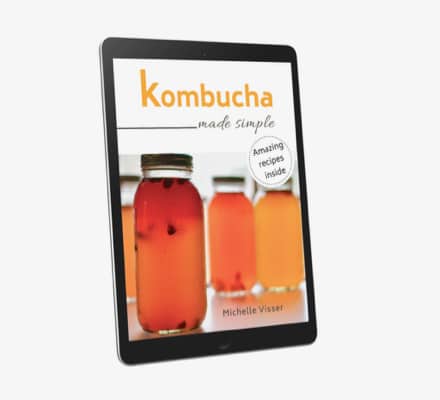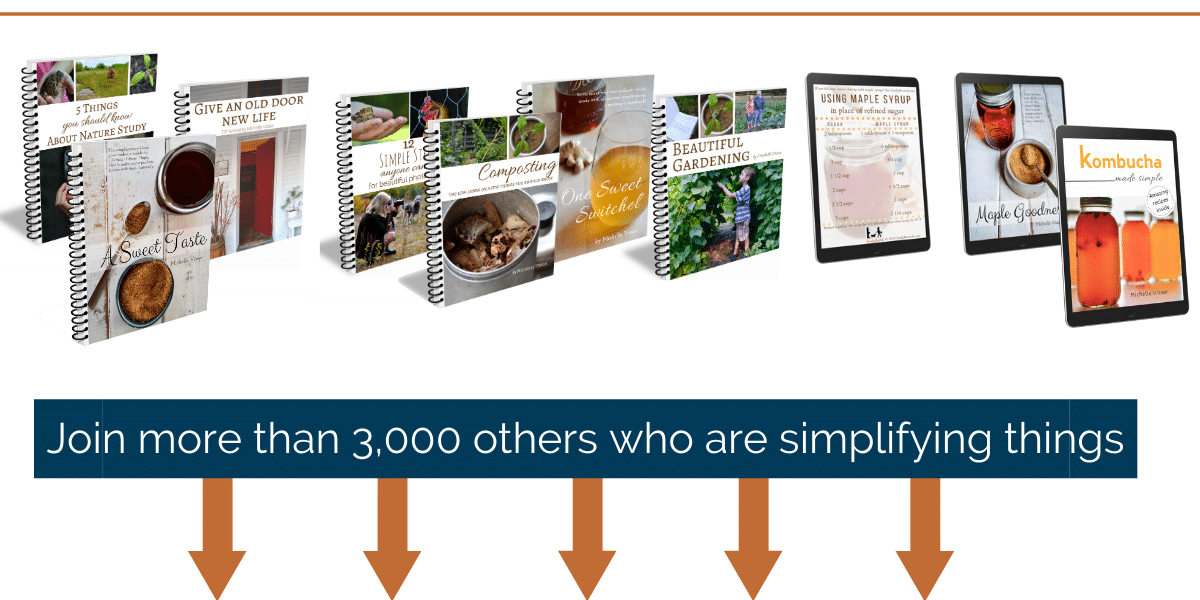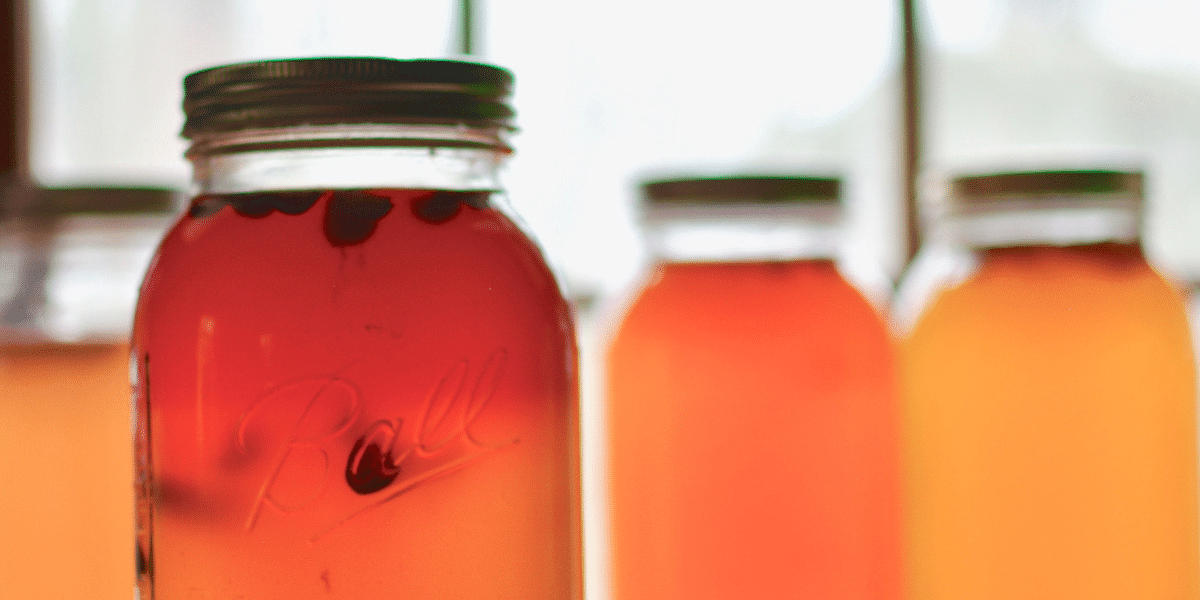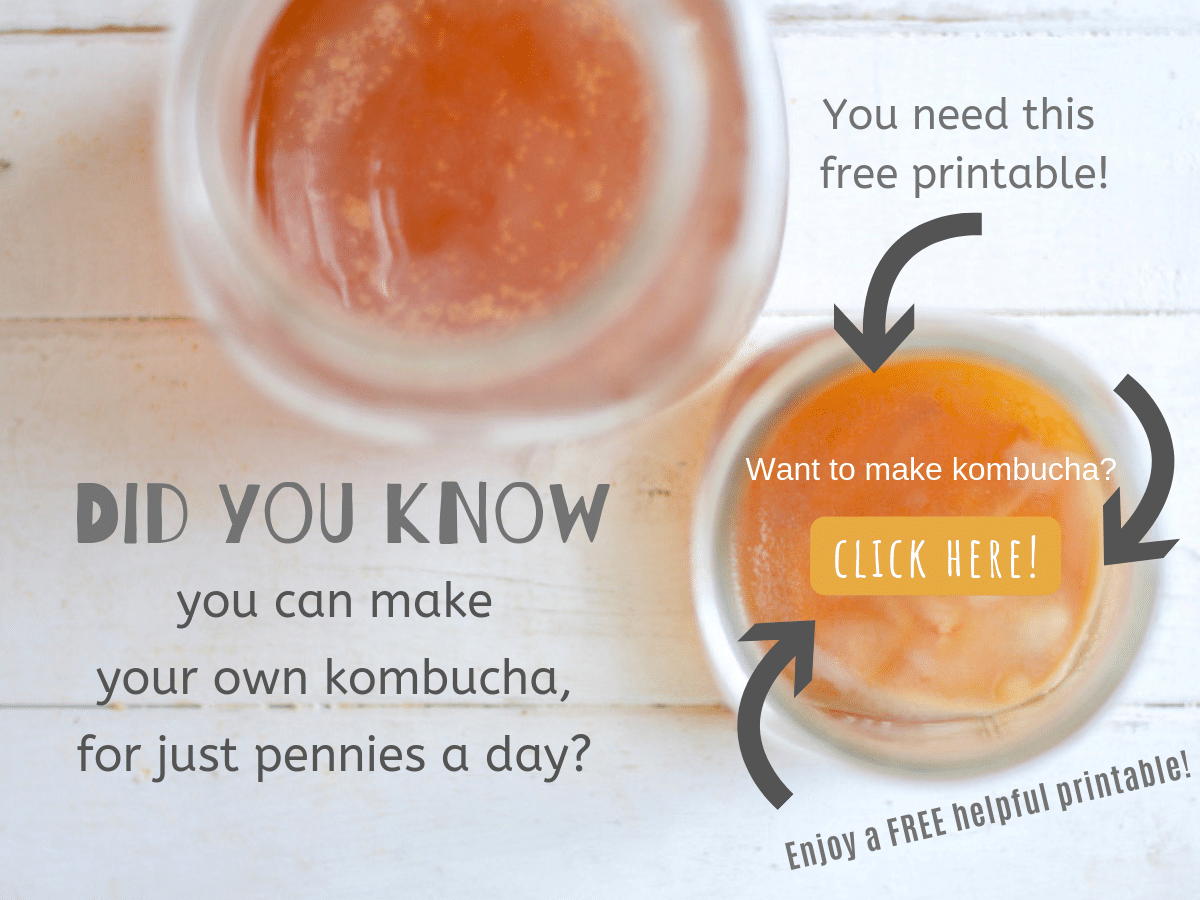Last Updated on June 20, 2024 by Michelle
Kombucha (n): A delicious fermented drink that can be made at home. That could be one definition., but for me? it goes more like this…
Kombucha (n): A source of daily joy. Yes, it’s that good, folks. Read on for the recipe for one of my favorite DIY kombucha flavors.

When I first started making kombucha, I struggled with getting the fermentation just right.
Then I learned a lot about how to regulate the fermentation, encourage or discourage the natural yeast formation, monitor the pH levels so they’re just right, and choose the perfect first ferment teas and second ferment flavors. (Which are all very simple things to learn, by the way, if you have them spelled out nice and simple, in one resource, which I couldn’t find anywhere… until I wrote Simple DIY Kombucha).
It doesn’t have to taste vinegary.
I learned that most kombucha–store-bought as well as DIY–has a vinegary undertone. I actually enjoy the subtle tang. In fact if I’ve nailed the fermentation time just right, it’s downright delicious.
But after a lot of experimentation with all different options of teas and flavors, I’ve discovered a wonderful combination that makes a “subtle” kombucha that doesn’t even have a hint of vinegar tang. I wouldn’t want every batch of kombucha to be this light and subtle. But wow is it a wonderful change of pace when I want a really refreshing drink.

So what’s the secret?
While the secret lies in this delicious brewing tea –especially blended for DIY kombucha–a few dried or frozen berries, and these wonderful organic dried roses, I’m certain you could experiment with your own options if you have something similar in your pantry.
If you want my exact recipe, look no further for a delicious cup of floral kombucha.
Rose Berry Kombucha
8 cups of kombucha (for this recipe, I use kombucha made with Mossy Rock Green Tea Blend and 1/2 cup sugar*)
1 tablespoon dried blueberries**
1 tablespoon dried roses**
- Place 8 cups of your prepared kombucha in a 1/2-gallon mason jar.
- Add other ingredients. (OR add 1 tsp of this wonderful kombucha flavoring tea: Rose Berry.)
- Seal jar tightly with a canning lid and rim (so carbonation can build up).
- Let the jar sit on your kitchen counter for 2-3 days.
- Feel free to turn the jar upside down and give it a gentle shake a few times a day to speed up the flavoring and carbonation process (but not necessary). The canning lid will start to buckle from the built-up carbonation, and you may notice a thin layer of yeast along the bottom of your jar when your second ferment is just about perfect. The time this takes does vary based on the temperature of your kitchen, but honestly you really can’t go wrong. When you want to drink it, it’ll be delicious.
* I often use this pure cane sugar for this kombucha recipe, but maple syrup is a delicious sweetener for this recipe as well. For that, though, you will need a maple-based scoby. Read here for more about how to make kombucha with maple syrup.
While this is my unrefined, pure cane sugar of choice, you can absolutely use standard refined sugar, if that’s what you use daily.
**Feel free to dry your own rose blooms, if you have access to organically-grown roses, but I use these organic dried roses. (They’re the best price I’ve found anywhere.)
**Use fresh or frozen berries–any kind really. I just prefer blueberries and I find these dried blueberries are the easiest, most convenient option.
If you would like to try the Mossy Rock Green Tea Blend and the Rose Berry kombucha flavoring tea that I love, use the coupon code SOULYRESTED and enjoy 10% off your entire order. Now that’s a Berry Rosey offer, no?
Side note: if you’re not a tea expert yourself, and aren’t well versed on the levels of tannins in various tea blends, always try a new kombucha recipe with a spare SCOBY, so you don’t risk harming your primary one. Tannins, btw, are one of the nutrients that a SCOBY needs to survive. And a SCOBY is a Symbiotic Culture of Bacteria and Yeast, which encourages the build up of lactic acid in a jar of kombucha.
Lactic acid improves irritable bowel syndrome, treats yeast infections, and improves our gut in more ways than I can list… Suffice it to say, it’s an essential part of your microbiome, or the balance of bacteria that lives in your body.

Want more great recipes for kombucha?
I put together a little deliciously fermented gift for you that I think you’ll love, and I parked it over in my Resource Library. (Go to this page if you’re already a subscriber.) Kombucha Made Simple–a 13-page, full-color book–along with numerous other resources on everything from parenting to gardening to homeschooling to sugarmaking… are all free for subscribers to download or access anytime.
other resources on everything from parenting to gardening to homeschooling to sugarmaking… are all free for subscribers to download or access anytime.
Why do I do this? That’s simple. It means the world to me when I hear from one of the thousands of folks who find a tidbit of encouragement or a helpful homesteading or recipe pointer buried somewhere in the hundreds of pages of my blog. I want to give back to you all. And I want to make my little “gifts” easy for you to access and refer to.
I wrote here about the many products I love for DIY kombucha.
This post is one you may want to pin until next Easter… how I used kombucha to dye eggs!
And here is yet another delicious floral kombucha recipe… Lilac blueberry.
Wanna know more about kombucha?–>
See how the flowers of the field grow. They do not labor or spin. Yet I tell you that not even Solomon in all his splendor was dressed like one of these. If that is how God clothes the grass of the field, which is here today and tomorrow is thrown into the fire, will he not much more clothe you? Matthew 6: 28-29
Pin this for later!
Click on an image below to pin this post.
Find out why SoulyRested was considered to be one of the Top 20 Must-Read Homesteading Blogs of 2018 and then one of the Top Homesteading Blogs of 2019 as well.
Glance at my Resource Page if you’d like to get a glimpse of other supplies I use for maple syrup making (as well as gardening, homeschooling, homesteading topics, nature journaling, and more).
Many readers often ask what camera I use to take the images you find here on SoulyRested. I love my Nikon; you can read more about my camera and even purchase your own here.
I’d love to connect!
To find me in some other neck of the woods, just click any (or every!) icon below:













Thanks so much for the tips!
So when I first let my tea, sugar and kombou sit on the counter for a few days, is it ok to have flowers (like hibiscus) in the mix? Will it damage the scoby?
Or can flowers and fruit only be added in the second fermentation process?
Thanks again, salud 🙂
Hi Anne-Marie, my course–Simple DIY Kombucha–goes into a lot of details about first ferment teas. Basically, the tea needs to have tannins. Hibiscus does. But it will most likely stain your scoby (which is okay).